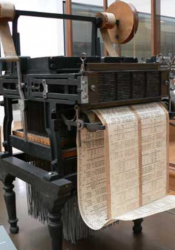Creation of The Analytical Engine
Middlemarch touches on many new and improved technologies for the occupants of the town. We see the integration of the rocket, literature, fashion and much more. With the creation and enhancement of these items we feel drawn towards a "dawning of a new age". A pivotal moment for the creation of new technology is Charles Babbage's creation of the analytical engine in 1834.
The analytical engine created a precursor for what is known as the, you guessed it, computer today! the blueprint for this invention was created in 1830 and was put to an stop in April of 1833 in order for some minor issues to be worked out and thus being put back on track in 1834. Charles Babbage stated his purpose being for inventing the analytical engine as "t is a machine to calculate the numerical value or values of any formula or function of which the mathematician can indicate the method of solution. It is to perform the ordinary rules of arithmetic in any order as previously settled by the mathematician, and any number of times and on any quantities. It is to be absolutely automatic, the slave of the mathematician, carrying out his orders and relieving him from the drudgery of computing. It must print the results, or any intermediate result arrived at." The intent of Babbage's invention was to alieviate the stress of the scholarly life that most "men" lived. i find this to be very interesting and some what ironic with a tie to Dorothea's relationship with not only Mr. Brooke but, also Casaubon. Dorothea herself acts almost as an analytical engine for the men in her life hoping to game some sort of knowledge while spitting out information back at them in hopes to further all of their studies.
The engine was composed of a set of rods that were "linked to wire hooks, each of which could lift one of the longitudinal threads strung between the frame. The rods were gathered in a rectangular bundle, and the cards were pressed one at a time against the rod ends. If a hole coincided with a rod, then the rod passed through the card and no action was taken. If no hole was present then the card pressed back the rod to activate a hook which lifted the associated thread, allowing the shuttle which carried the cross-thread to pass underneath. The cards were strung together with wire, ribbon or tape hinges, and fan, folded into large stacks to form long sequences. The looms were often massive and the loom operator sat inside the frame, sequencing through the cards one at a time by means of a foot pedal or hand lever. The arrangement of holes on the cards determined the pattern of the weave." not much is left behind of the works that were created on the engine and not many know how Babbage came to program or create this version on his own but it has paved the way for search engines and technology today.

